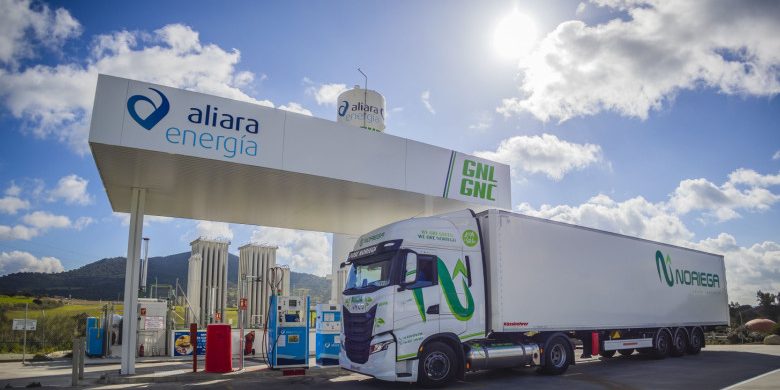Decarbonizing heavy transport largely depends on the use of renewable gases and their derivatives. This is one of the main conclusions of the report “The decarbonization of heavy transport in Spain and Portugal”, carried out by the Technological Research Institute of the Comillas Pontifical University and commissioned by Gasnam-Neutral Transport, which informs that these fuels have prevented emissions to the atmosphere of 500,000 tons of CO2 in the Iberian Peninsula in 2022.
The study carries out a diagnosis of the current state and the use of alternative fuels in the land and maritime heavy transport sector in the Iberian Peninsula. This is an essential sector to achieve a carbon-neutral economy by mid-century, but it is currently strongly dominated by petroleum-derived fuels due to the high energy density it demands and which converts renewable gases and their derivatives (biomethane, hydrogen and e-fuels) in the solution to face the climate challenge.
Biomethane, an immediate solution for the growing number of natural gas-powered heavy vehicles and ships
23% of new bus registrations in Spain in 2022 were CNG vehicles, while the share of LNG-powered truck registrations reached 4.6%.
Spain is the third country in Europe in CNG bus fleet and the first in truck fleet. However, and despite the fact that these vehicles can already run on biomethane without making any type of modification, less than 1% of the gas consumed in transport in 2022 was of renewable origin. This is a very different situation from that in other countries, where the share of biomethane in transport reaches 95% in Sweden or 90% in Germany.
In the maritime sector, despite the fact that more than 99% of the world fleet runs on petroleum-derived fuels, 2021 and 2022 have broken a record for orders for LNG-powered ships and these fleet is expected to multiply by 2.5 before 2030.
Advanced development of the supply infrastructure for biomethane in road and maritime transport
Spain has 250 CNG/LNG refueling points, to which must be added 30 in the project, all of them capable of supplying biomethane without having to make any type of modification.
In the maritime field, it should be noted that in 2022 LNG bunkering operations were carried out for ships in 16 ports in the Iberian Peninsula, making it a benchmark at a European level. In addition, Spain and Portugal have an advantageous position with regard to the supply of hydrogen-derived fuels to ships, since a large number of ports already carry out logistics operations with ammonia and methanol today.
Deployment of biomethane production capacity accelerates
The Report highlights that an exponential increase in biomethane production is expected, which could multiply by 10 in Spain between 2022 and 2025.
Despite the determining role that biomethane can play in the decarbonisation of transport, in Spain there are only 8 production plants (349 GWh/year) and 13 pilot plants (22.86 GWh/year), with less than 4% of that capacity being allocated production for transportation in 2022. Seven of the commercial plants inject biomethane into the natural gas network, while the pilot plants focus on producing biomethane for direct use in vehicles.
Spain, far from meeting the ambitious objectives for the deployment of hydrogen service stations requested by Europe
In 2022, hydrogen fuel cell buses timidly began to make their way with the incorporation of nine vehicles, despite the almost non-existent network of stations. Spain has nine hydrogen refueling facilities, of which only two are publicly accessible.
These figures are far from the objectives set for 2030 in the Hydrogen Roadmap (100-150 for Spain) and in the European AFIR regulation that proposes a filling station open to the public every 200 km in the TEN-T network and in the urban centers.
These stations must also have the capacity to supply one ton of hydrogen daily and at least one 700bar pump. However, most of the nine existing hydrogen facilities in Spain have a supply capacity of less than 100 kg/day, an amount far distant from that requested by Europe.
Transportation, one of the main consumers of renewable hydrogen projects
The report also includes the great interest that exists in producing renewable hydrogen and its derivatives, with nearly 100 green hydrogen production projects in the Iberian Peninsula, of which a third have declared that part of their production will be used for transport. According to these data, the accumulated electrolysis power in Spain would amount to 18.1 GW, far exceeding the objective set in the Hydrogen Roadmap of 4 GW in 2030. However, most of these projects are still in a very preliminary phase.
The implementation of the regulatory reforms pending approval in Europe will bring strong pressure to decarbonize the sector
The transformation of the heavy transport sector is in an embryonic phase. However, the intense legislative activity in Europe will imminently translate into a set of regulatory levers that will activate the decarbonization process, establishing obligations for all segments of the value chain from production to user, through supply or vehicle.
The biggest boost comes from the Fit for 55 package of measures, a set of regulations designed to reduce greenhouse gas emissions by at least 55% by 2030. Of all of them, the incorporation of the transport sectors into the system of ETS, as well as emission intensity reduction requirements (RED III, FuelEU Maritime). These regulations are complemented by the REPowerEU plan with the upward revision of the objectives for the production/consumption of hydrogen and the promotion of biomethane as key tools to promote the energy transition.
Photo: Aliara Energía
Source: Gasnam







